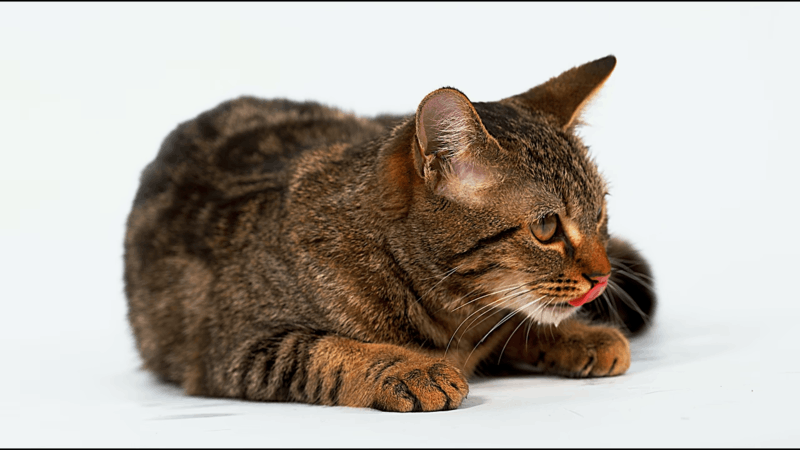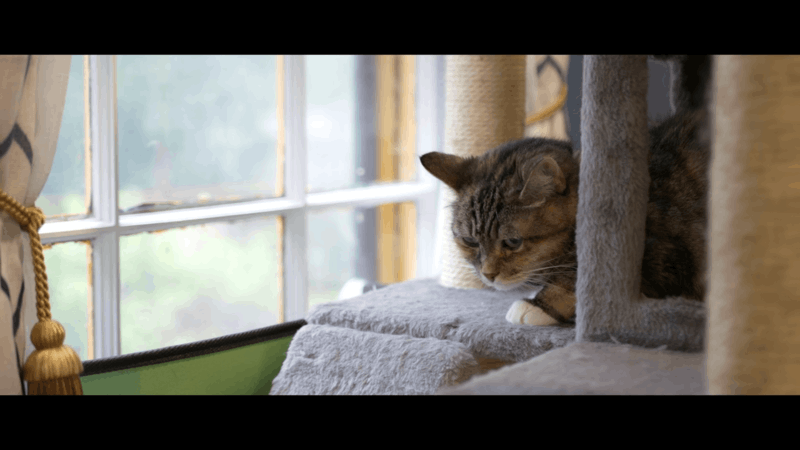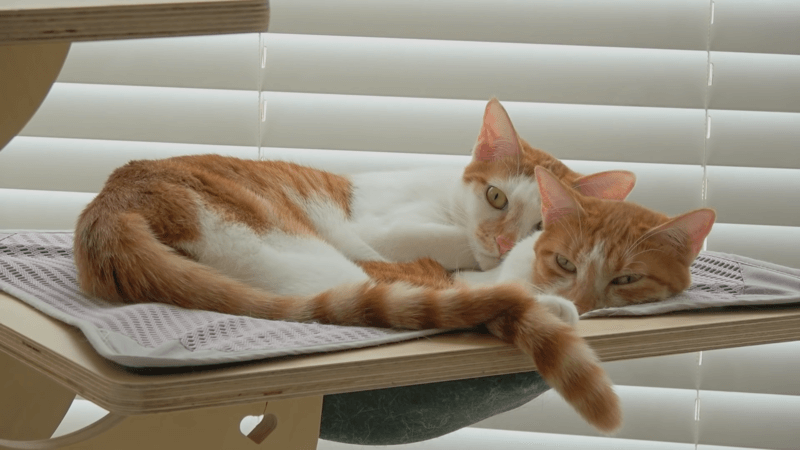No products in the cart.
Seeing your furry friend lose patches of their beautiful coat can be alarming; hair loss in cats is a common concern among pet owners. Anything from minor allergies to major medical conditions can be the cause of feline alopecia.
The common reasons behind hair loss in cats, effective home treatments, and the best foods to support a healthy coat will be explored in this blog. Discover the ways to help your cat regain their luxurious fur and ensure they stay happy and healthy.
What is Hair Loss in Cats?

Hair loss in cats (or another name is alopecia), is a disorder that causes a cat to lose all or part of its fur. This may happen more widely throughout the body or only in certain places. To provide appropriate care and resolve the issue effectively, understanding the underlying causes is so important.
The underlying cause of the symptoms, which might include visible coat thinning, bald patches, or excessive shedding, is generally diagnosed and treated with veterinarian care.
What Causes Hair Loss in Cats?
Many different conditions can cause hair loss in cats, with variable degrees of severity and approaches to therapy. Understanding the underlying causes is crucial for providing appropriate care and resolving the issue effectively.
- Allergies: Cats can develop allergies to food ingredients, environmental factors like pollen or dust, and flea bites, causing itching and hair loss.
- Parasites: Fleas, mites, and lice are common parasites that irritate a cat’s skin, leading to excessive scratching and hair loss.
- Fungal infections: Ringworm, a common fungal infection, causes circular patches of hair loss, often with redness and scaling.
- Hormonal imbalances: Hyperthyroidism or Cushing’s disease are some of the conditions that can disrupt hormonal balance, leading to thinning fur and hair loss.
- Stress or anxiety: Psychological factors like stress and anxiety in cats can cause cats to groom excessively, resulting in bald patches.
- Nutritional deficiencies: A poor diet lacking essential nutrients can affect a cat’s coat health, leading to hair loss.
Addressing hair loss in cats requires identifying and treating the underlying cause. A veterinary examination is essential to diagnose the specific issue and recommend an appropriate treatment plan, ensuring the cat’s coat health and overall well-being are restored.
Is Hair Loss a Sign of Cancer in Cats?
Hair loss in cats is not always a direct indicator of cancer, however, it can occasionally be connected to serious underlying diseases or specific cancer types. For example, skin tumors or cancers affecting the endocrine system can cause hair loss. Besides, hair loss in cats can be the result from cancer treatments, such as chemotherapy.
Consulting a veterinarian for a clear examination to rule out cancer and other serious health issues is crucial when a cat is experiencing unexplained hair loss.
Common Areas of Cat Losing Hair

Cats can experience hair loss in specific areas of their bodies for various reasons. Determining the site and pattern of hair loss could provide important hints to the underlying cause. The following are some typical spots where cats lose hair:
- Cat Hair Loss on Head
Intense itching and scratching are frequently caused by parasites like fleas or mites, which result in hair loss on a cat’s head.Allergies, fungal infections such as ringworm, or behavioral issues like over-grooming due to stress can also lead to hair loss in this area.
- Cat Losing Hair in Front of Ears
Hair loss in front of a cat’s ears is typically a sign of ear mites or other ear infections. Cats may scratch or rub their ears excessively to alleviate discomfort, resulting in hair loss. Dermatitis and allergies are other frequent causes.
- Cat Hair Loss around Neck
Hair loss around a cat’s neck can result from flea infestations, as fleas often congregate in this area. It can also occur due to an allergic reaction to a collar or topical medications. Additionally, infections or injuries from scratching or fighting can lead to hair loss in this region.
- Cat Losing Hair on Tail
Hair loss on a cat’s tail is often associated with flea infestations, as cats may chew or scratch their tails to relieve itchiness. Allergies, hormonal imbalances, and stress-induced over-grooming are other possible causes.
- Cat Losing Hair on Belly and Legs
Hair loss on a cat’s belly and legs can be caused by stress or anxiety, leading to excessive grooming. In certain regions, fungal illnesses like ringworm, allergies, and parasites like fleas or mites can also result in hair loss. The fur on the belly and legs might also thin due to hormonal problems and specific medical diseases like hyperthyroidism in cats.
To identify the underlying cause and the best course of action when you observe hair loss in any of these areas in your cat, consulting a veterinarian is advised.
Home Treatment for Cat Hair Loss

Home treatment for cat hair loss involves addressing the underlying cause and providing supportive care. Ensure your cat is on a balanced diet rich in essential nutrients to promote skin and coat health. Regular grooming can help distribute natural oils and remove loose fur. Use flea control products to prevent infestations, and keep your cat’s environment clean to reduce allergens.
Providing a stress-free environment and using calming products can help if stress or anxiety is a factor. For mild skin irritations, applying a vet-approved topical treatment can soothe the affected area. Before starting any home treatment, do not forget to consult with a veterinarian. He can give you the professional instruction and advice which are safe and appropriate for your cat’s specific condition.
Food for Cat Losing Hair
If your cat is experiencing hair loss, dietary adjustments can play a crucial role in addressing the issue. To encourage a healthy coat and lessen hair loss in cats, consider the following foods:
- High-quality protein: Foods such as chicken, turkey, or fish need to be included in your cat’s diet. Protein is essential for healthy fur growth.
- Omega-3 and omega-6 fatty acids: Foods high in these acids, such as salmon or cat food with extra ingredients, should be taken into consideration to enhance coat health and decrease shedding.
- Biotin and B vitamins: These vitamins support skin and coat health. Look for cat foods that are fortified with biotin and B vitamins.
- Hydration: To maintain a healthy coat, keeping your cat hydrated is so important and you can add wet cat food or water to dry food to the daily meal of your feline.
- Limited ingredient diets: If allergies are suspected, consider a limited ingredient diet to identify and eliminate potential allergens that may be causing hair loss.
- Specialized hairball control foods: These can reduce hairballs, which in turn can help with hair loss issues.
Ensuring your cat receives a balanced and nutritious diet is vital for maintaining their overall health, including the condition of their coat. If hair loss persists, consult with a veterinarian for further advice and potential treatments.
How Fast does Cat Hair Grow Back?
Cat hair growth rates vary depending on the individual cat and the reason for hair loss. Generally, the full regrowth of a cat’s hair might occur over a few weeks to many months.
Factors such as the cat’s age, overall health, the severity of the hair loss, and whether the underlying cause has been effectively addressed will influence the regrowth rate.
In most cases, once the underlying issue is resolved, you can expect noticeable improvement in the hair coat within 4 to 6 weeks, with full regrowth potentially taking up to 3 to 6 months.
Conclusion
Hair loss in cats can be concerning, but understanding its causes and treatments is key to restoring your cat’s lush coat. Identifying and addressing issues like allergies, parasites, and stress can promote healthy regrowth. With proper care and a balanced diet, your cat’s fur can return to its full, vibrant state. Always consult your veterinarian for tailored advice, ensuring your cat stays happy, healthy, and comfortable.
Hello, I am Hazel Bennett, an experienced copywriter specializing in the fascinating topic of CBD for dogs. With a passion for pet wellness and extensive knowledge of CBD’s potential benefits, I am here to provide you with informative and engaging content.



